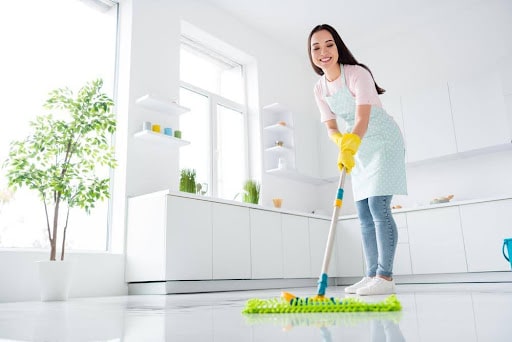Table of Contents
If you’ve ever bemoaned the relentless buildup of dust coating every surface in your home, know that you’re not alone. Countless others are puzzled by the source of this persistent dust, often mistakenly assuming it originates inside.
Research indicates that 60% of the dust collecting inside our homes is generated outdoors and carried in by us. This can trigger hay fever from indoor allergens like dust mites, shed skin and pet fur. Removing dust from your home can alleviate symptoms, making the spring and summer seasons more enjoyable. But what’s the best way to reduce buildup?
If your goal is to lessen allergy-inducing dust, or if you want advice on eliminating pollen and pet dander, there are several simple strategies to achieve this — and not all require deep cleaning! For example, installing a DIY mini split can reduce dust and pollen indoors by using advanced filtration to clean the air as it circulates, providing a cleaner and healthier living environment.
Ready to enjoy a sneeze-free home? Use our easy tips for removing dust and pollen and make your living space a breath of fresh air.
1. Give Your Home a Thorough Dust
Regular dusting is key to preventing dust buildup in your home. Use a damp cloth, sponge or static duster pad to capture dust and prevent particles from flying into the air. A vacuum attachment can be helpful for hard-to-reach spots, such as baseboards.
For an effective and eco-friendly option, consider investing in washable microfiber cloths. They’re affordable and excellent at trapping dirt and grime on various surfaces, making your cleaning routine more efficient.
2. Vacuum Your Home Often
Frequent vacuuming keeps dust off your floors and stops it from gathering. Even a quick sweep with the vacuum can clean out the deep-seated dirt and grime in your carpets. Experts suggest going carpet-free in your living spaces if you have serious allergies. Doing this can reduce allergens and help make the air in your home cleaner and fresher.
3. Invest in a Home Purifier
While some can come with a higher price tag, air purifiers excel at capturing most airborne dust and particles in your home. Not only do they reduce dust production, but purifiers also cut down on pollen, smoke odor and pet dander levels — a big win for anyone battling allergies.
Look for models that offer High-Efficiency Particulate Air (HEPA) filters. These are critical for capturing particles as small as 0.3 microns with 99.97% efficiency, including pollen, pet dander, dust mites and other airborne pollutants. Also, if you’re concerned about odors from pets, cooking or smoke, an activated carbon filter can absorb these smells, providing a fresher indoor environment.

4. Clean Your Floors with a Mop
For homes with laminate, wood or stone floors, mop with a vinegar and warm water solution once a week to remove accumulated dirt. High-traffic areas like kitchens and bathrooms require more frequent mopping, especially in households with multiple people.
Floors often contain more germs than we realize, invisible to the naked eye. Regular mopping mitigates allergy risks and restores the natural shine of your floors, making them appear freshly installed.
5. Install a Mini Split System
Imagine breathing in fresher air daily, free from annoying dust and pollen. That’s exactly what you get when you build your own mini split system. Tailored specifically to your home’s needs, these systems are not just about keeping the perfect temperature in each room; they’re armed with HEPA filters or other cutting-edge tech that combats dust mites, pollen and other airborne allergens.
You can achieve a cleaner, healthier living space with reduced allergen levels by designing a multi-unit system that fits your home’s unique layout and air quality requirements. This custom approach ensures that the air circulated throughout your home is filtered more effectively, making it an ideal strategy for allergy sufferers and anyone looking to improve their indoor air quality.
6. Choose Eco-Friendly Cleaning Solutions
Using harsh chemical cleaners can increase the dust in your home by sending unwanted particles into the air. It’s worth scanning the labels for non-toxic ingredients, like baking soda, distilled vinegar or lemon oil, which can make a big difference to the air you breathe.
When stocking up on cleaning supplies, choose organic, natural choices like Castille soap to maintain a clean home and pure air. Or consider the simple effectiveness of a damp cloth and water, proven by research to be surprisingly efficient.
7. Use a Ceiling Fan
Using a fan, particularly from the Big Ass Fans brand, can reduce dust and pollen in indoor environments. The strategic design of Big Ass Fans enables them to circulate air more efficiently across large spaces, which helps not only in cooling down rooms but also in displacing airborne particles like dust and pollen. By keeping the air in motion, these fans prevent the settling of dust and allergens on surfaces, reducing accumulation and potential triggers for allergy sufferers.
8. Tidy Up Your Living Space
Kicking off a deep spring cleaning? Remember that dust loves to settle on items that don’t get much attention, so regular decluttering can contribute to a dust-free home. Consider going through your drawers, shelves and attic boxes to find items like clothes, toys and books you can pass on to someone else. This not only lifts your spirits and clears your space but also helps reduce dust accumulation.
9. Invest in a Doormat
Placing doormats at the entrances of your home might seem like a small step, but it’s surprisingly effective in cutting down on dirt. The idea of blocking all outdoor debris from entering your house might seem a bit ambitious, but that doesn’t mean you can’t reduce it.
A doormat can catch a lot of unwanted dirt, grime and pollen before it even has a chance to get inside, making your home cleaner and easier to maintain. Then, simply vacuum or take the doormat outside and shake it to get rid of the dust.

10. Clean Your Bed Sheets and Mattress
Changing your bed sheets regularly is vital; this is a hotspot for dust and dust mites. Try to change your sheets once a week to ensure your bed stays clean and dust-free. You may need to change these more than once weekly if you suffer from severe allergies.
It’s also important to clean your mattress every six months. You can do this simply by removing the cover, sprinkling some bicarbonate of soda on top and vacuuming it off.
Breathe Easier with a Dust-Free Home
Transforming your home into a haven free from dust and pollen might sound impossible, but with the right tricks up your sleeve, you can enjoy a cleaner, more hygienic home. From installing a DIY mini split to regular cleaning rituals like swapping out your bed sheets every week to mastering the art of the detailed dust-off, you can transform the air in your home so you can breathe more easily.
Image Source – Shutterstock
Read More on KulFiy:
